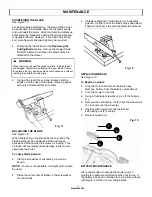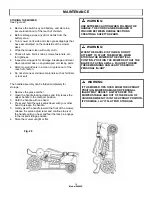
IMPORTANT SAFETY INSTRUCTIONS
3
Model 60062S
SAFETY INSTRUCTIONS FOR PEDESTRIAN
-
CONTROLLED
MOWERS
WARNING:
READ AND UNDERSTAND ALL INSTRUCTIONS
Failure to follow all instructions listed below and on the
machine may result in electric shock, fire, and/or serious
personal injury.
IMPORTANT
-
Safe Practices for Pedestrian
-
Controlled
Mower
This machine is capable of amputating hands and feet and
throwing objects. Failure to observe the following safety
instructions could result in serious injury or death.
I. GENERAL INFORMATION
1.
Read, understand, and follow instructions and warnings in
this manual and on the machine, engine and attachments.
2.
Only allow operators, who are responsible, trained, familiar
with the instructions, and physically capable to operate the
machine.
3.
Keep bystanders away.
4.
Do not operate the machine while under the influence of
alcohol or drugs.
II. PREPARATION BEFORE OPERATING
1.
Clear the operating area of any objects which could be
thrown by or interfere with operation of the machine.
2.
Keep the area of operation clear of all bystanders,
particularly small children. Stop the machine and
attachment (s) if anyone enters the area.
3.
Do not operate the machine without the entire grass
catcher, discharge chute, or other safety devices in place
and functioning properly. Check frequently for signs of wear
or deterioration and replace as needed.
4.
Wear appropriate personal protective equipment such as
safety glasses, hearing protection, and footwear.
III. OPERATING
1.
Only operate the machine in daylight or good artificial light.
2.
Avoid holes, ruts, bumps, rocks, or other hidden hazards.
Uneven terrain could overturn the machine, or cause
operator to lose their balance or footing.
3.
Do not put hands or feet near rotating parts or under the
machine. Keep clear of the discharge opening at all times.
4.
Do not direct discharge material toward anyone. Avoid
discharging material against a wall or obstruction. Material
may ricochet back toward the operator. Stop the blade (s)
when crossing gravel surfaces.
5.
Do not leave a running machine unattended. Always park
on level ground, disengage the attachment, and stop
engine.
6.
Do not mow in reverse unless absolutely necessary.
Always look down and behind before and while backing.
IV. CHILDREN SPECIFIC
1.
Tragic accidents can occur if the operator is not alert to the
presence of children. Children are often attracted to the
machine and the mowing activity. Never assume that
children will remain where you last saw them.
2.
Keep children out of the operating area and under the
watchful care of a responsible adult other than the
operator.
V. SLOPE SPECIFIC
Slopes are a major factor related to accidents. Operation on
slopes requires extra caution.
1.
Travel in the manufacturer recommended direction on
slopes. Use caution while operating near drop
-
offs.
2.
Avoid mowing wet grass. (Poor footing could cause a slip
and fall accident.)
3.
Do not operate machine under any condition where
traction, steering, or stability is in question. Tires could slide
even if the wheels are stopped.
4.
Always keep the machine in gear when going down slopes.
Do not coast downhill.
5.
Avoid starting and stopping on slopes. Avoid making
sudden changes in speed or direction. Make turns slowly
and gradually.
6.
Use extra care while operating machine with a grass
catcher or other attachment (s). They can affect the stability
of the machine.
VI. HAULING
1.
Use full width ramps for loading and unloading a machine
for transport.
VII. SERVICE
1.
Keep machine in good working order. Replace worn or
damaged parts.
2.
Use caution when servicing blades. Wrap the blade (s) or
wear gloves. Replace damaged blades. Do not repair or
alter blade (s).
3.
Remove or disconnect battery before servicing or making
any repairs.
WARNING:
California Proposition 65:
This product contains chemicals known to the State of
California to cause cancer, birth defects or other reproductive
harm.
WARNING:
Some dust and debris created by the use of this
tool could contain chemicals known to the State of California to
cause cancer and birth defects or other reproductive harm.
Some examples of these chemicals are:
Chemicals in fertilizers
Compounds in insecticides, herbicides and pesticides
Arsenic and chromium from chemically treated lumber
Your risk from exposure to these chemicals varies, depending
on how often you do this type of work. To reduce your
exposure, work in a well
-
ventilated area and with approved
safety equipment, such as dust masks that are specially
designed to filter out microscopic particles.
WARNING:
Cancer and Reproductive Harm –
www.P65Warnings.ca.gov.




































